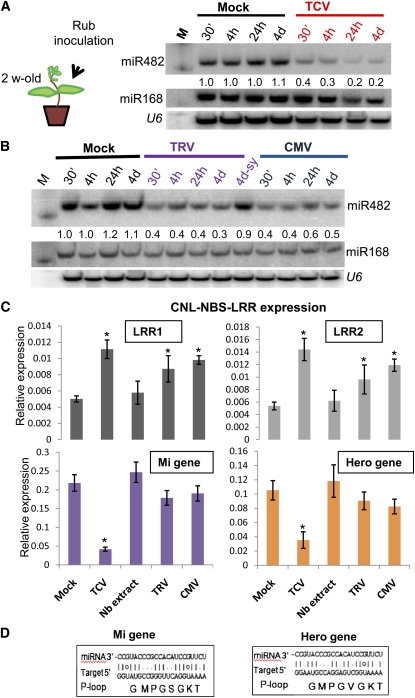Figure 7.
miR482 Silencing of NBS-LRR mRNAs Is Suppressed in Virus-Infected Plants.
(A) RNA gel blot analysis of miR482 in TCV-infected tomato leaves. Total RNA from TCV infected and noninfected leaves of N. benthamiana was inoculated to M82 tomato (TCV and Mock). RNAs isolated at the indicated times after inoculation were separated on a 15% polyacrylamide gel. The RNA was transferred to a membrane and probed with radiolabeled DNA oligonucleotides for miR482 with miR168 and U6 probes as loading controls. M, decade marker indicating a 20-nucleotide RNA.
(B) RNA gel blot analysis of miR482 in TRV- and CMV-infected tomato leaves. Total sap from TRV infected, CMV infected, and noninfected leaves of N. benthamiana were inoculated to M82 tomato (TRV, CMV, and Mock, respectively). RNAs isolated at the indicated times after inoculation were separated on a 15% polyacrylamide gel. The RNA was transferred to a membrane and probed with radiolabeled DNA oligonucleotides for miR482 with miR168 and U6 probes as loading controls. 4d sy, tissue from systemic uninoculated leaf; M, decade marker (Ambion) indicating a 20-nucleotide RNA.
(C) Quantitative PCR analysis for the abundance of two miR482 target mRNAs (LRR1 and LRR2) (Top) and Mi and Hero NBS-LRRs that are not targets of miR482 (Bottom; see [D]). RNA was extracted 4 h after inoculation. Error bars indicate sd (n = 3), and asterisks indicate a significant difference from corresponding control samples (t test, P value < 0.05).
(D) The best target sequences of miR482 with Mi and Hero mRNAs.

